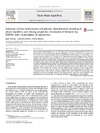Identificador persistente para citar o vincular este elemento:
https://accedacris.ulpgc.es/jspui/handle/10553/52084
| Campo DC | Valor | idioma |
|---|---|---|
| dc.contributor.author | Ortega, Juan | en_US |
| dc.contributor.author | Sabater, Gisela | en_US |
| dc.contributor.author | Fernández, Luis | en_US |
| dc.contributor.other | Fernandez, Luis | - |
| dc.date.accessioned | 2018-11-25T17:20:34Z | - |
| dc.date.available | 2018-11-25T17:20:34Z | - |
| dc.date.issued | 2015 | en_US |
| dc.identifier.issn | 0378-3812 | en_US |
| dc.identifier.uri | https://accedacris.ulpgc.es/handle/10553/52084 | - |
| dc.description.abstract | Isobaric vapor–liquid equilibria at p = 101.32 kPa (iso-p VLE) and the mixing properties, hE and vE, are determined for a set of twelve binary solutions: HCOOCuH2u+1(1)+CnH2n+2(2) with u = (1–4) and n = (7–9). The (iso-p VLE) present deviations from the ideal behavior, which augment as u diminishes and n increases. Systems with [u = 2,3 n = 7] and [u =4 , n = 7,8] present a minimum-boiling azeotrope. The non-ideality is also reflected in high endothermic values, hE > 0, and expansive effects, vE > 0, for all the binaries, which increase regularly with n. However, for a same hydrocarbon, the properties diminish with increasing u. This, in turn, causes the dipolar effect of the methanoates to decrease, with the resulting reduction in mixing effects. As a result, other interpretations on the behavioral structural model of these systems are established. Modeling of the experimental quantities is carried out using the authors’ model with good results, and comparisons are made with an adapted version of the NRTL model. Energetic properties of the solutions are predicted with the UNIFAC group contribution model, but the values obtained are not as good. Hence, parameters corresponding to the specific interaction HCOO/CH2 are recalculated using a wider database, resulting in slightly better values. COSMO-RS methodology is also employed to assess the energetic effects of the mixing process. Apart from some exceptions, also mentioned here, the method gives an acceptable estimation of the behavior of these systems. | en_US |
| dc.language | eng | en_US |
| dc.relation.ispartof | Fluid Phase Equilibria | en_US |
| dc.source | Fluid Phase Equilibria [ISSN 0378-3812], v. 402, p. 38-49, (Septiembre 2015) | en_US |
| dc.subject | 3303 ingeniería y tecnología químicas | en_US |
| dc.subject.other | Vapor liquid equilibria | en_US |
| dc.subject.other | VLE | en_US |
| dc.subject.other | Mixing property | en_US |
| dc.subject.other | Alkyl methanoate | en_US |
| dc.subject.other | Alkane | en_US |
| dc.subject.other | Modeling | en_US |
| dc.title | Solutions of alkyl methanoates and alkanes: Simultaneous modeling of phase equilibria and mixing properties. Estimation of behavior by UNIFAC with recalculation of parameters | en_US |
| dc.type | info:eu-repo/semantics/article | en_US |
| dc.type | Article | en_US |
| dc.identifier.doi | 10.1016/j.fluid.2015.05.031 | en_US |
| dc.identifier.scopus | 84930932655 | - |
| dc.identifier.isi | 000358464100005 | - |
| dcterms.isPartOf | Fluid Phase Equilibria | - |
| dcterms.source | Fluid Phase Equilibria[ISSN 0378-3812],v. 402, p. 38-49 | - |
| dc.contributor.authorscopusid | 7402623992 | - |
| dc.contributor.authorscopusid | 35112937200 | - |
| dc.contributor.authorscopusid | 12799553900 | - |
| dc.identifier.absysnet | 715936 | - |
| dc.identifier.crisid | 874;17987;- | - |
| dc.description.lastpage | 49 | en_US |
| dc.description.firstpage | 38 | en_US |
| dc.relation.volume | 402 | en_US |
| dc.investigacion | Ingeniería y Arquitectura | en_US |
| dc.rights.accessrights | info:eu-repo/semantics/openAccess | - |
| dc.type2 | Artículo | en_US |
| dc.identifier.wos | WOS:000358464100005 | - |
| dc.contributor.daisngid | 170099 | - |
| dc.contributor.daisngid | 685735 | - |
| dc.contributor.daisngid | 4845685 | - |
| dc.identifier.investigatorRID | M-1895-2014 | - |
| dc.utils.revision | Sí | en_US |
| dc.identifier.supplement | 874;17987;- | - |
| dc.identifier.supplement | 874;17987;- | - |
| dc.identifier.supplement | 874;17987;- | - |
| dc.identifier.ulpgc | Sí | en_US |
| dc.contributor.buulpgc | BU-ING | en_US |
| dc.description.sjr | 0,874 | - |
| dc.description.jcr | 1,846 | - |
| dc.description.sjrq | Q1 | - |
| dc.description.jcrq | Q2 | - |
| dc.description.scie | SCIE | - |
| item.fulltext | Con texto completo | - |
| item.grantfulltext | open | - |
| crisitem.author.dept | GIR IDeTIC: División de Ingeniería Térmica e Instrumentación | - |
| crisitem.author.dept | IU para el Desarrollo Tecnológico y la Innovación en Comunicaciones (IDeTIC) | - |
| crisitem.author.dept | GIR Fabricación integrada y avanzada | - |
| crisitem.author.dept | Departamento de Ingeniería de Procesos | - |
| crisitem.author.dept | GIR Fabricación integrada y avanzada | - |
| crisitem.author.dept | Departamento de Ingeniería de Procesos | - |
| crisitem.author.orcid | 0000-0002-8304-2171 | - |
| crisitem.author.orcid | 0000-0002-6924-3444 | - |
| crisitem.author.orcid | 0000-0002-6924-3444 | - |
| crisitem.author.parentorg | IU para el Desarrollo Tecnológico y la Innovación en Comunicaciones (IDeTIC) | - |
| crisitem.author.parentorg | Departamento de Ingeniería Mecánica | - |
| crisitem.author.parentorg | Departamento de Ingeniería Mecánica | - |
| crisitem.author.fullName | Ortega Saavedra,Juan | - |
| crisitem.author.fullName | Fernández Suárez, Luis Jesús | - |
| crisitem.author.fullName | Fernández Suárez, Luis Jesús | - |
| Colección: | Artículos | |
Los elementos en ULPGC accedaCRIS están protegidos por derechos de autor con todos los derechos reservados, a menos que se indique lo contrario.
